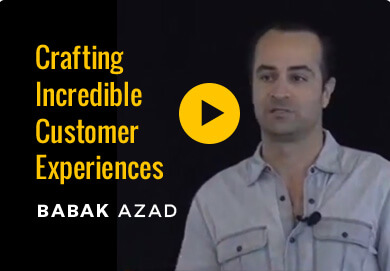For the most part, the days of “do you factor in online sales when you run TV media” questions are generally over. And so most traditional DRTV marketers have a website that primarily receives traffic driven thru TV media. But what many DRTV marketers don’t do well is drive cold traffic online. Below is a smattering of what I’ve learned with my time with some of the top digital marketers out there.
1. The pace is totally different, and you’ll likely have to battle ingrained cultural norms to be successful
I combined 2 points which I think are actually the 2 most important and the 2 biggest challenges DRTV folks have when it comes to digital. Everything online is faster than in the TV world. That’s not an attack on the DRTV world – almost like criticizing an oil tanker for not having a smaller turning radius. That’s because the process of putting something up on TV just takes longer. It has to be higher quality, historically stations only aired tapes (it’s gradually getting better), and as a result the cost of switching tapes is not free like it is when you want to switch SEM copy. Plus, if you lived in a world where you sent paper materials to your customers, that just exaggerated how “just right” everything had to be.
This results in certain types of cultural norms and business processes, frankly that were necessary to save money, avoid mistakes, etc. But in the world of online marketing, very little has to be perfect. Far from it. Not to mention, newer companies have the advantage of new technologies. You can literally get an online store up and running in a couple hours with Shopify. Google Analytics provides free tracking and analytics tools. WhatRunsWhere allows you to see what banner ads your competitors are running – to the point that you can download them and build your own.
But more than anything, people starting in digital media today just expect to operate at a fast pace. And the cost for DRTV folks comes both in opportunity cost, not to mention in trying to attract partners and employees from the digital world who are not frustrated by the “normal” pace within these organizations.
I can’t overemphasize this point enough. Just as some larger traditional companies have established new offices in Silicon Valley, it might be worth a new space (or at least part of the office) to allow the digital folks to do their thing.
2. Remember that cold traffic to your site from online media is probably not nearly as qualified as it is from your TV marketing
One of the huge benefits of running media on TV, especially long-form, is that you get the opportunity to educate, inform and excite your potential customers before they get to the landing page. As such, traditional landing pages for DRTV marketers don’t have to do as much selling as providing some additional and supporting info, and then to get out of the way of allowing a customer to purchase.
Driving cold traffic from online media to a site is akin to getting someone to click on the program guide. That’s just the first step. Depending on where they’re coming from, the content on the page – whether written, images, a video, or something else – needs to then do the job that the infomercial did. That’s because the customer is in a total different state of awareness. You can’t just put a buy button at the top of the page. Just because a customer doesn’t click doesn’t mean they aren’t interested; it’s just that it’s the wrong sequencing. My friend Perry Belcher (one of the sharpest guys out there) really taught me this lesson.
3. Online video (especially YouTube) is different than TV video
TV viewers expect a certainly level of quality, and are accustomed to a certain pace. Same with online viewers. Except that those 2 are different for an online viewer than a TV viewer (even if it’s the same person). For example, using multiple cameras for TV is normal, but on YouTube, while there are certainly some exceptions, direct-to-camera is the norm. And whereas a TV viewer expects clean cuts from one scene to another, online, consumers have become accustomed to somewhat choppy edits – if the result means less dead air and getting to the point faster.
Not to mention the form factor of mobile – people just can’t read as much on their smartphone as they can when they watch on their 40-inch flatscreens. This sounds like an obvious point, but check out how many videos you watch on your phone that have copy that is unreadable. And to those that say they didn’t realize or intend for consumers to watch it on their phones, well, that’s partly the point – consumers are doing things on their terms now more than ever before.
4. You need to learn a new language, but just like a foreign language, don’t try to learn it all at once
The following is a list of some of the more commons terms in digital marketing today:
SEO, SEM, Email, Affiliates, display, Social (FB, Twitter, Pinterest, YouTube, I/G, Periscope, Snapchat), VSLs, long-form vs. short-form sales letters, retargeting, drip-campaigns, reputation management, auto-responder sequences, exit pops, webinars, content marketing
Hopefully, many of those are familiar to you. And while you don’t have to know and use every single one of those, it’s about learning what different types of strategies and tactics are out there and then deciding which one(s) are relevant for your business.
Note: If you don’t have the foundations of SEO, SEM (especially brand search), retargeting (both thru Google and Facebook), and basic email marketing in place, I’d get those squared away first before touching anything else. The reason I say that is your TV media is already affecting those buckets, so I’d get traffic from your TV media sorted out first before adding new media.
5. You need to go hang out with new people
Just like learning a foreign language, you need to start going to the places where the people who are speaking this new language are hanging out. The beauty (and at times overwhelming part) is that there are a ton of conferences and events. One thing to note is that most of the events are content-heavy – where you spend most of your time in educational sessions, as opposed to in suites simply meeting folks. Traffic & Conversion Summit is one of the best events out there. There are a ton of affiliate events such as Affiliate Summit East/West, LeadsCon, etc. And NewsCred just put on one of the better content marketing events recently – what was particularly great was that I couldn’t make the event in NYC but they live-streamed it for free.
6. Sharing of information happens in a different way, especially amongst marketers
This point extends from the one just above. One dynamic that I’ve been utterly blown away by in the digital marketing world is the extent to which people share information. And I’m not talking about general statements such as “we use SEM to drive our traffic.” But I’ve seen folks break down the exact ads they ran, the funnel they run people through, how they retarget non-converting leads, their metrics, and much more. And in rooms where direct competitors were present. It’s pretty amazing. That’s a big part of what makes the educational sessions so highly-attended. There is high-quality content being shared. You may need to learn this new language, and fortunately there are tons of resources and people out there willing to teach you – sometimes even for free (see my prior post on podcasts – http://goo.gl/PH18xE).
2 highly-recommended resources I’d suggest:
-Digital Marketer – www.digitalmarketer.com – their blog is excellent and their DM Lab is unreal cheap ($39/month) for great content. At the very least, join their email list.
-Neil Patel – probably one of the best content marketing guys out there. If you go thru his posts, he will pretty much teach you content marketing to a level of detail that you didn’t expect – he posts in a couple places – http://neilpatel.com/blog/ and http://www.quicksprout.com/blog/ .
7. You need to buddy up with Google and Amazon
Two particular relationships that have to be built are with Google and Amazon (especially if you’re in the physical products world – see my prior post about Amazon – http://goo.gl/KFQBMG). Presumably you have been doing this anyways but it warrants repeating. Neither of them is going anywhere. They are big gorillas that are not afraid to push people around. But they are also HUGE drivers of traffic and revenues. And so a strong relationship there can make a big difference.
8. Facebook should probably be a 3rd required relationship
I’m amazed that people still aren’t running ads on Facebook. At the very least, it should be used for retargeting. But I know people running 6-figure media dollars each week on Facebook. Profitably. Certainly, Facebook, just as Google has done, has started tightening up their compliance on what they do and don’t allow, but that just means being creative and adapting. And pretty much to be expected – each new property usually allows almost anything and everything to attract as many people as possible, and then once they’ve hit some sort of scale and feel like they can push back on advertisers (or just users in general), they start doing so. But re: Facebook, it’s essentially a monster database marketing tool. Not just for killing time…
9. Don’t stress about perfection in the way you do with TV (and print)
Already mentioned this above. But it bears mentioning a second time. Most everything can be pulled down and changed if you don’t like it. Find a way to get tests up as quickly as possible. Ad copy tests, images, landing page tests, back-end tests. Wherever you have traffic is where you should be looking to test. Just make sure you prioritize your higher points of leverage and that tests are kept apart, even if one is on the front end and the other is on the back end.
10. Your digital marketing employees and agencies aren’t nearly as focused on the phone channel as you are
It might feel like I’m being critical of DRTV folks. Far from it. Many have had a level of success that you have to appreciate. But this post is about an area where most DRTV marketers have fallen short and how to make improvements, not about talking about all the things that have been done well.
That being said, one area that deserves mention – because of implications on the digital side – is the phone channel. Most DRTV marketers show a toll-free number on the screen (BTW, at least on TV, you should be using 800 numbers – not as important on your site, but definitely on TV). As such, they (you) probably have a sense of the value of the phone channel. Most digital marketers don’t have that experience. So how and where you can add in the opportunity for people to respond via phone, even if it’s not primary, is where you’ll have to be mindful.
11. There are analogues to PI media
In the online world, they’re affiliates, who you pay per order, lead, or whatever is agreed upon. Just be aware that fraud is much much worse with online affiliates than PI agencies (where in my experience it was rare). If you’re going to work with affiliates, you have to have someone watching for fraud. And while in the DRTV world, PI is considered an add-on, there are plenty of online marketers who drive traffic almost entirely through affiliates (working with ClickBank, CJ, Share A Sale, and others).
12. Technology can make a big difference
And likely if you’ve been around for a while, yours is outdated. That doesn’t mean scrap everything and start from scratch. It doesn’t mean go spend $5MM. But it does mean that you should explore what’s out there (this article is 3 years old but it’s even more true today – http://goo.gl/EJz65h).
13. Your digital folks need to know what the rest of your business is doing
Whereas people only call an inbound telemarketing phone number after seeing your spot or show, pretty much anything can drive someone to your site, social properties, etc. A mention on a news program, an inadvertent Tweet, a user-generated video that goes viral. The company’s website and social properties need to be recognized as downstream of pretty much everything else. So while they might be in a different part of the building, they need to be kept in the loop. And they need to communicate effectively with the rest of the organization.
It’s been exciting to see how some DRTV marketers have embraced the digital world. My fear is that others continue to ignore it or simply choose to reject it. But just as companies are starting from scratch these days, it’s totally reasonable for traditional DRTV folks to build up their digital marketing capabilities, even if it feels like it’s from scratch.
There’s a lot of really cool stuff and opportunities out there. And it’s only growing.
Please leave a comment below because I’d like to hear what you think.






Hey would you mind stating which blog platform you’re working with?
I’m looking to start my own blog soon but I’m having a tough time selecting between BlogEngine/Wordpress/B2evolution and Drupal.
The reason I ask is because your layout seems different then most blogs and I’m looking for something unique.
P.S Sorry for getting off-topic but I had to ask!
sure. it’s a genesis theme for wordpress. sixteen nine pro.
-babak
We are a group of volunteers and opening a new scheme in our
community. Your web site provided us with valuable
information to work on. You have done a formidable job and our entire community will be grateful to
you.